The Gryphon
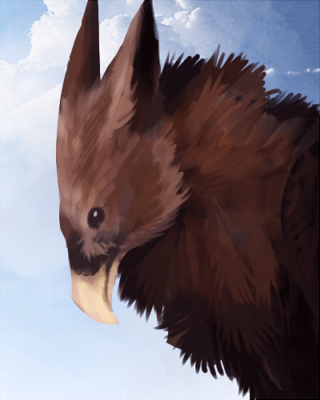
General Information;
The gryphon is a creature that has both avian and feline qualities; most often, these are large animals with the forequarters and wings of a bird, and the hindquarters of a cat. They are found in two distinct variants, as well as a multitude of subspecies. Gryphons congregate in flocks called 'Flights' found across numerous Realms.
Statistics;
Name:: Gryphons
Average Lifespan:: 750 years
Average Height:: 4ft/1.2m at the shoulder
Average Weight:: N/A; depends on individual
Location Found:: Abroad. Many found in Shi'vrann'aeli and Alubria.
*all statistics based on averages; extremes in any direction, or found in odd locations, are always allowed.
Notes;
Insults As proud as gryphons are, they often bristle if their Flight or type are ever insulted. Common insults for Grandmane gryphons are 'floofbutts' and 'granny gryphs', where Sleekwings are often called 'birdboned' and 'birdbrained'. Mixblooded gryphons commonly find themselves being called by names such as 'dirtbloods', 'dirtyfeathers', and 'mudgryphs'. Duels may be initiated over such insulting names, and many an offending individual has found themselves at the mercy of the sharp beaks and talons of an angry beast.
Diet This is what this species, and any variants, may eat at any given time.
Common:
Grandmanes-
large prey; red meat.
Sleekwings-
medium to small prey; red meat. sometimes fish or fowl.
Mixbloods-
varies, but trends towards larger prey and red meat.
Uncommon:
Grandmanes-
smaller prey; white meat. sometimes crustaceans and other shellfish.
Sleekwings-
nuts and berries. insects; eggs.
Mixbloods-
nuts and berries, plants, insects; carrion.
Rare:
Grandmanes-
carrion; flora and fungi.
Sleekwings-
carrion; bone marrow specifically.
Mixbloods-
semi-dry bones. mushrooms and fungi.
Overview:
Gryphons are a pseudo-apex predator species, generally appearing at the top of the food chain if larger species (such as dragons) are not in the area. They will hunt anything as large or larger as them, depending on whether or not they think they can catch and successfully kill it. However - unlike many other predators - gryphons will not partake in prey that is sapient if they can so help it. Grandmane gryphons hunt prey that is commonly larger than they are, a testament to their great strength, while Sleekwings will target prey smaller than they are. Mixbloods are immensely varied, though they will often eat things their parent variants will not touch.
Of the gryphon subspecies, the majority have different feeding patterns and diets they adhere to. The Anquil gryphon will eat anything living, sapient or not - often while it is still alive. Drakyns are most similar to Grandmanes, though tend to enjoy their prey cooked and prepared more than their cousins. Hippogryphs do not often hunt, though they can be omnivorous; they graze on long grass primarily, and will eat tree leaves and/or flowering shrubs should the opportunity present itself. Lastly, Yorijian gryphons often hunt large fish for their meals.
Credits;
Species info credited to Verridith, Fyfergrund, and Kyariel.
In-Depth Information;
Appearance Gryphons may be found in a variety of appearances, but always retain a few solid traits: they have four legs and at least one pair of wings, birdlike faces, and bodies covered in fur, feathers, or a mixture of both. All are quadrupedal, though some may use their wings for auxiliary climbing or walking stabilization, and their feet may be any mixture of birdlike or catlike. Some may display more avian traits than others, while certain individuals may carry a more feline build. Many have been found with unique mutations, such as horns, extra eyes, tails, wings, and more. Size may vary from the size of a large dog to much larger than a horse, though those as small as faegryphs are rare.
Colors in gryphon offspring may vary widely from parent to chick; gryphons are prone to being born with accent colors that are not present in their lineage, or base colors several hues outside of their predicted range. As such, some gryphons may appear to be wildly different than other relatives, where others may look like a perfect blend. This phenomena may skip generations, or hit every chick from every clutch. Nothing is known as to why this color oddities occur, though the members of nearly every established Flight claim it is a gift from the gods themselves.
Grandmane: Grandmane gryphons are large and heavy creatures with wide wings and thick fur. They are muscular, sturdily built, and solidly put together. Many sport leonine manes or ruffs of fur, along with luxurious pelts that may grow hair up to feet in length from their tails, chests, paws, and backs. Grandmanes also have a higher chance of being born with feathered crests and poofy frills, along with thicker plumage. Plates, horns, and spikes are common mutations.
Sleekwing: Slender and delicately built, Sleekwing gryphons are graceful creatures with narrow wings and long, thin legs. They are often tapered and refined in appearance, often mistaken for being overtly fragile, though they are more resilient than they appear. Sleekwings are generally smaller than Grandmanes, and have short coats with limited plumage, ranging mostly in decorative trailing feathers, tail-fans, and other ornamental features.
Mixbloods: Mixblooded gryphons, as they are called, hold traits of both variants; they are conceived of Grandmane and Sleekwing pairings, and may range in appearance anywhere on the spectrum. However, few mixbloods will be completely Grandmane or Sleekwing in build - they often appear to have traits of both.
CultureAs a whole, gryphons are known to be strong and proud; many are fiercely loyal to those that they hold dear, and react quickly to threats against themselves and their families. A group of gryphons is called a 'Flight', and is usually led by a mated pair. The Aran'raa and Tari'rae (male and female respectively) hold absolute authority over their Flight, and leadership of thus is passed by blood. However, if the pair have no offspring, it is passed through contest.
Each Flight has their own rituals and traditions, and hunting parties - usually led by a second in command (the Arfae and Arfaern, male and female), or appointed hunt-leaders called the Far'cora and Far'cai - are sent out once every few days to gather prey or other food. Older gryphons and chicks are often allowed to eat before fit adults, and the end of a hunt is praised by the Aran'raa and/or Tari'rae of that Flight. Many flights will save the bones, teeth, and claws of their prey and design jewelry and trinkets to share and trade with others, including those outside of their race.
Grandmane and Sleekwing gryphons may form Flights together in certain places where gryphons are in abundance; however, Grandmanes tend to range more in colder climates, where Sleekwings prefer warmer, more open areas. Flights with primarily Grandmane individuals have been known to be more aggressive and territorial, where Sleekwing Flights are more easygoing and laid back. The largest Flight that holds both Grandmane and Sleekwing individuals, including several Mixbloods, is the Anarya of Alubria.
Abilities Vastly intelligent, and adept both physically and magically, gryphons are powerful adversaries and loyal allies to any they hold worthy of their trust and protection. Most gryphons have some affinity for elemental magic, and healers are quite common; reiatsu is not uncommon, and others may have abilities over metal-weaving, the Sight, and many more besides. Those born without power are still physically capable, and often become excellent hunters and warriors alongside their Flightmates.
Grandmane: Grandmane gryphons are larger and stronger than their counterparts; elemental affinities often trend towards earth, fire, and darkness. They may have greater defensive capabilities, and hold a higher stamina than others, able to run and fly long past the point when a Sleekwing needs rest.
Sleekwing: Slim Sleekwings are very, very fast; they may outrun a Grandmane with ease, though cannot run for as long, or as far. Sleekwing gryphons are nearly unparalleled in the sky among their brethren, and are capable of incredible aerial feats. In elemental affinity, Sleekwings are prone to air, water, and light.
Species Origin;

The gryphon's first origins came from an impossible love story; a strong stonelion, with a long silver mane and white as snow fur, and a female roc shifter with feathers painted like the night sky. They encountered one another in the tallest mountain peaks, as the male was prideless and alone, and the female was without a flock. He seemed infinitely sad, and so the roc shifted into a small cat to follow him without being seen, wishing only to find what had his heart so low.
He talked to himself much through his journeying, and she learned he had lost his betrothed to a freak accident in the Realm of his birth. The stonelion was a coward, and had run; his guilt was immense, and she felt sorry for him. Shifting into a female stonelion, the roc trotted up to him one morning and greeted him warmly, her pelt black and shimmering with a thousand white speckles, like glittering stars. She told him she was alone, and that he seemed sad; they agreed to travel together, for companionship and protection against the many dangers the mountains held.
It was not long before feelings for the male blossomed in the roc shifter; and through the long months they traveled, her feelings were returned. She became pregnant in due time, and carried within her a single child, carrying in stonelion's form for a long while. The couple were happy; and to anyone looking on, they looked only like a pair of stonelions beginning a new pride.
However, when the cub was born, the stonelion male recoiled. It was a mutant! A monster! Confused and horrified, he looked as his mate smiled sheepishly: for the cub had the naked face of a wide-eyed bird of prey, and scaled talons in place of leonine forepaws. It only had a lion's rump and tail, a sleek belly, with then-featherless wings sprouting from a cub's back. "What have you done?" the stonelion asked, "That cub is not mine!" The roc shifter looked surprised and fearful, before she beheld her cub for herself.
Then, she smiled, nuzzling her baby as laughter bubbled up inside of her. "Oh, my love, I am so sorry - I should have told you before," she said to her shocked mate. "I am a shapeshifter; I beheld you long ago, and shifted into this form. I have not shifted back since, as I fell in love with you, but it seems that my genes of a roc have carried to our child. Fear not, my love; for she is yours through and through."
It took some time for the stonelion male to be convinced; it was only when the roc had recovered enough to show him her true form that he forgave her for her secrecy, and they came to love their hybrid child as much as any purebred cub. As the cub grew, it caught the attention of more than a few - including, oddly enough, the eyes of a goddess mystified by such true and unbroken love.
When the cub grew into an adult, and long after the stonelion had died and left the roc alone, Zeldrima took the hybrid and sent her to sleep; the creature had grown into a beautiful thing, her fur and feathers all shades of silver and black, a perfect blend of her parents. She was a powerful combination of strength, agility, and grace. The goddess took bones of old stonelions and feathers roc'a had shed and crafted others in the hybrid's likeness, gifting her and her new fellows magic and great intelligence, long lives, and power. You are no longer a hybrid, young one, she intoned as the original woke.
You will go by a new name; you, and those who will follow you. Gryphons, will you all be called; you are the beautiful hunters and huntresses of the sky, and you will fly high and far and fast, even as the dragons who will rule you do. Go forth in your new Flight, and cry out to the skies of your kin and kind!
Thus were the race of gryphons born; and thus, their wings filled the skies forevermore.
This species did not have an Ancient First.
subspecies
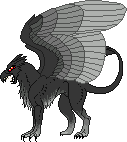
Anquil Gryphon
Classification: magically-twisted, demonic gryphon. Location: Anquil, Evylon.
The Anquil gryphons earned their horrific appearance withstanding the constant magestorms of Anquil, an unprotected region in the far north of Evylon. Their mercilessness is known near and abroad. The last thing many see is the Anquil gryphon's rows of razor sharp teeth, encased in a beak divided into four sections, allowing them to consume larger prey even as it struggles.
Anquil gryphons frequently have multiple sets of eyes, which are often shades of red or orange. Their long, overgrown talons are curved and strong and are a rare treasure for weapons-makers. The gryphons' fur is often slick like oil and dark in color, appearing sleek, smooth, and almost beautiful in comparison to their terrifying jaws. While otherwise they appear as normal gryphons in basic shape and anatomy, they are most often found with the Grandmane build, as lighter Anquilans are physically weaker than broader and more muscled individuals.
These creatures kill and eat however they please, with very little regard for regulation. Some have said that the birds are insatiable and an Anquilan with a lesser wit might gorge itself to death. Entering an Anquilan's territory is certain death for most, as they will either eat an intruder alive or kill them for a later meal. Anquilan prides are led by the largest and most well-fed, called the 'alpha' or 'alphess', and operate similarly to crude lupine packs. Succession is determined through trial by combat and the lesser of the two is commonly eaten alive by the victor. The Flight leader is ruthless to a fault, forced that way by survival of the fittest, and is greatly feared even among family.
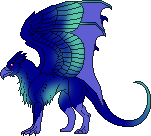
Drakyn
Classification: dragon-based gryphon. Location: primarily Alubria in Felnova, and the northern parts of Millirand.
Renowned for their beauty, drakyn gryphons began as descendants of dragon-gryphon unions, eventually evolving into their own unique subrace. The range of color, pattern, and shape is indefinite, and can lean to either draconic or gryphonic direction, though all have scales to some degree. Commonly, markings across the subspecies are similar to those found in felines, tabby and calico among them, though more unusual patterns are not uncommon. Iridescence is very common, as is bright ornamentation both natural and not. Male drakyn have astounding antlers or horns, found in a variety of shapes and textures. Occasionally, female drakyn will also sprout more delicate horns or antlers which can be a sign of maturity.
Their kinship with dragons is strong and they often follow codes of conduct that align with more draconic ideals. Some may try to make connections with humans or elves, but it is merely symbolic of the relationship between a dragon and rider. Perhaps due to this, they have a tendency to be more collaborative and accommodating than others of their species. Drakyn are somewhat more likely than others of their kind to entertain guests rather than chase them out, and may even welcome honorary members into their Flight.
In abilities, drakyn often have greater strength than traditional gryphons, no matter if their body type ranges closer to Swiftwing or Grandmane. Most have magical affinities and elemental powers, the extent of which varies from individual to individual. They are also strongly inclined to be wildwhispers, able to speak with animals of all kinds, and often form bonds with specific animal species that they hold throughout their lives. This allows them to communicate with common fauna easily, though it is seen as more than immoral to use their wildwhisper abilities to hunt with, and such may be used a grounds to exile one from the Flight.
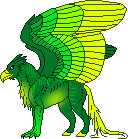
Hippogryph
Classification: horse-based gryphon. Location: Alubria, Felnova; Lizzarkyth.
The hippogryph is a gryphon best-known for having the hindquarters of a hooved beast, most commonly horses and other large ungulates. Their forelegs are routinely avian, with large talons and scales that sheath their paws entirely, sometimes extending all the way up to the elbow. Feathers are common covering the forequarters, as is feathers, though leonine manes are very rare. Their wings are large, often broad, and are consistently feathered. Mutations are common, and hippogryphs have been noted that may have the mane of a horse or the antlers of a stag. In coloration, hues range across the board, though natural and horse-colors are most common.
Like their hoofed counterparts, hippogryphs often live on open land, in deserts or plains. They're commonly omnivorous, thought some have given up all forms of meat. They can frequently communicate with species they are closely related to, such as horses or deer. Thus, the large, intelligent beasts often feel a sense of obligation to protect neighboring herds, and refuse to hunt the animals they are most like.
The origin of gryphons lies in obscurity, though there are rumors of a union between gryphons and equus mares. It is more likely that the hippogryphs adapted to an environment with an abundance of grasses and leaves and their forms reflect other species common in their environment. A kinship between unicorns and hippogryphs was also formed long ago and unions between the two are fairly common. It's not unusual for a hippogryph to be accepted into a herd of unicorns, pegasi, or any of their subspecies, and such beasts may act as protectors for the entire herd.
Hippogryphs form Flights that are more herd-like and often in close proximity to herds of other species, with whom they share resources. They often choose flight over fight, though they are well-known for coming to the defense of neighboring herds when predators roam within their territory.

Ne'le Gryphon
Classification: wingless gryphon. Location: mainly Alubria, though they can be found anywhere.
There is a subspecies of gryphon well-known for its lack of wings; originally born of a mutation that causes a hatchling to develop without wings, many have banded together over time and have established themselves to be a subspecies in their own right. They were frequently abandoned by their families and left to die, cast out and exiled from their true Flights. Those younglings that survived became the ne'le, and now are well-respected among their more liberal kin.
While they can be found in any Realm, ne'le gryphon Clans are commonly found in Alubria, residing nearby other gryphon Flights in case of a mutated birth. While their winged counterparts may feel shame and humiliation at these births, the Clans rejoice. They commonly celebrate and greet new members at the turn of each season, and have established ties with Flights so that they may take in first-generation ne'le without trouble.
In recent years, Clans of Millirand have began to claim territory in the plains and lowlands of the Realm; as such, territorial disputes between the ne'le and the morra Sin have heightened. Competition for land and prey have resulted in skirmishes, though rarely breaks into all-out war. Ne'le in these regions have begun to look at all morra Sin and their related species with distrust, and friendship between the two is so rare as to be unheard of.
While other gryphon types have clear hierarchy and leadership, the ne'le gryphons often look to a leader solely for guidance or conflict resolution. In all other respects, the leader of a Clan is considered an equal, save for in rare cases.
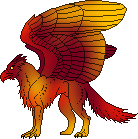
Sky'ree Gryphon
Classification: canid-based gryphon. Location: northern, icy climes.
Isolated in the cold norther regions, the sky'ree are both bird and canine. They are often built similar to Grandmane gryphons, with slim Sleekwing builds much rarer. The sky'ree often resemble wolves with thick fur and broad shoulders; some may closer resemble foxes or wirehair hounds, though short fur is also uncommonly possible. Both fur and feathers may come in any color, with any markings, though it's very common that their pelts and plumage changes color with the seasons. A sky'ree's forelegs may be either avian talons or lupine paws, and they may have either large canid ears or feathered tufts.
The sky'ree Flights are small in comparison to other gryphon Flights. They are each led by a pair of gryphons - the Draug'aran and Tari'ronyo - who have absolute power, much like a wolf pack's alpha and alphess. The Flights often reside in isolated areas well-guarded by ice and trees. Though they do not collaborate with other gryphons, they may make connections with wolves, werewolves, and worgen.
Some sky'ree Flights have been known to live alongside dog or wolf packs, coexisting in a mutually beneficial alliance. The sky'ree gryphons can often communicate in ways that other common canines understand, giving them some influence over packs. This wildwhisper ability is, however, only restricted to canines - they cannot extend it to other animal types, though other magic is very common.
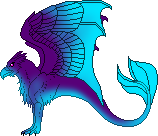
Yorijian Gryphon
Classification: aquatic and semi-aquatic gryphon. Location: abroad, located near bodies of water.
Yorijian gryphons come as varied as the fish in the sea or the birds in the sky. Their size can vary based on where they live, but few get much larger than a small whale. Color and form are often also determined by habitat, where Yorijian gryphons who live in the depths may have sleek hide and webbed appendages and amphibious gryphons may have scales or even a water-resistant fur or feathering. It is unusual for a Yorijian gryphon to be born with fins rather than claws, though possible.
A particular skill of Yorijian gryphons is communication. Their wide array of communication styles and their ability to communicate with related aquatic creatures, has made them popular messengers among the dragons of Yorijie. Yorijian gryphons who prefer colder waters are often messengers for the dragons of Starwhal, who are known to travel beyond the the bounds of Yorijie.
As with other denizens of Yorijie, magic use is less common, though Yorijian gryphons may develop elemental affinities to water or ice. Their skills commonly lie in record-keeping and communication and they are commonly peaceful. Many have developed ways of record-keeping underwater, and their waterproof materials are highly sought after even among those of other races.
Flights of Yorijian gryphons are hierarchically rigid but there are commonly attempts to develop a meritocratic approach to succession. Lone gryphons or small Flights do occasionally attach themselves to groups of other species, whether for survival or out of curiosity. Some of these move to waters outside of Yorije, and can be found in many Realms in small numbers.
